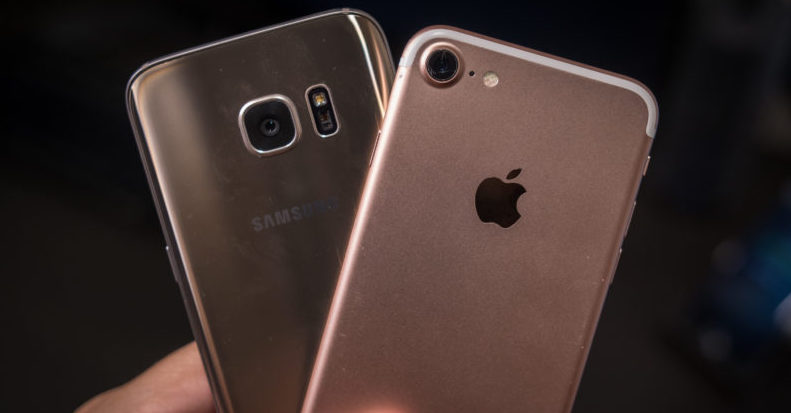Nearly ten years ago, Steve Jobs began the modern smartphone industry with the launch of the iPhone. While Apple dominated in the cellphone industry, the Android platform struggled with an equal alternative. Three years later, Samsung reached success with the release of the Galaxy S.
From that point on, it was clear that there would be a smartphone rivalry between Apple and Samsung, and to this day it has held true. While other good smartphones erupted and faded away, these two phones remained stable. Here, we compare the evolution of both the iPhone and the Galaxy S series and see how the latest phones of the series compare today.
In 2010, Samsung was finally ready to introduce an answer to the iPhone. The Galaxy S featured many amazing specs that first led to the competition between the two companies. The large 4-inch phone display featured a resolution of 480 x 800 pixels. Slim for the plastic body of the phone, it also featured a new and hardly used screen technology: the super AMOLED. The AMOLED screen allowed for each pixel to be controlled individually. The Galaxy S also featured an excellent 5-megapixel camera, which could record video in 720p, regarded as HD. In comparison, Apple first phone with any kind of OLED screen was the iPhone X.
The iPhone 4, which Apple released in 2010, was the prime competitor of the Galaxy S. To many Apple loyalists, the iPhone 4 was the best iPhone of all time. The iPhone 4 featured the first major redesign of the iPhone, introducing a stunning new glass and metal design, which was very aesthetically pleasing and replaced the duller plastic design. In addition to that, it had the highest display of all time, named ‘Retina’ display. The iPhone 4 was so phenomenal that its immediate successor, the iPhone 4s, is practically indistinguishable to the naked eye. There would not be another significant redesign of the iPhone series until the iPhone 6 came out in 2014.
Today, with the release of iPhone X (which reads ten) in November of 2017, which also marks the ten year anniversary of the iPhone, and Galaxy S8 on April of 2017, the competition between Apple and Samsung is up and running again. Both companies have made incredible changes and still control the majority of the smartphone market.
With the immediate difference of price, iPhone X seems overpriced at $999 while the Galaxy S8 starts at $750. The specs of both the iPhone X and Galaxy S8 are similar with Galaxy having slightly better stats. Both phones have a 5.8 inch screen display with 12MP rear cameras. The Galaxy S8 has the first dual-lens camera in a Galaxy S-series phone, although the Galaxy Note 6 did have a dual-lens camera. The first iPhone with a dual-lens camera was the iPhone 7+. While the iPhone X has stereo speakers, the Galaxy S8 doesn’t seem to be able to play stereo sound without headphones. The thicknesses are approximately the same at around 0.3 inches, but the iPhone X is slightly thinner. However, the iPhone X weighs more than both the S8 and the S8+. Additionally, the Galaxy S8 wins in the front camera and has more RAM at 4 GB instead of 3 GB on the iPhone. The iPhone X was found to have a 19.5-hour battery life, falling short of the 26-hour life of the S8. Both phones feature a way to unlock the phone using one’s face, while the S8 has a variety of other biometric authentications including iris and fingerprint scanners. Meanwhile, the iPhone X dropped Touch ID (the fingerprint sensor) in favor of Face ID. Another new feature on the iPhone X is wireless charging. However, the Samsung Galaxy S series has offered wireless charging since the S6, which was released in 2015. The iPhone X comes with up to 256 GB of storage, while the Galaxy S8 comes with 128 GB. However, continuing in an Android tradition, the S8 offers a microSD expansion slot. Samsung offers various microSD cards with capacities going up to 256 GB for a maximum total of 384 GB of storage on the Galaxy S8. Even with this storage expansion installed, the Galaxy S8 is still cheaper than the iPhone X.
Apple and Samsung both abandoned their home buttons in a revolutionary move, making the usable screen size bigger. However, Apple may have copied off the S8 design, or vice versa. As soon as the S8 abandoned its home button, which gave the S8 more screen room as well as a more glossy and slicker look, Apple came out with its latest phone and abandoned its iconic home button as well.
Both phones feature potent processors, resulting in excellent responsiveness. However, a main difference is the display resolution. The iPhones have always struggled with its screen resolution, comparatively speaking, while the Galaxy S series has always had impressive screen resolution. This year, the iPhone X bumped up its resolution game, with 1125 x 2436 pixels, giving it an appealing pixel density of 459 ppi. However, this once again pales in comparison to the fantastic S8 resolution, 1440 x 2960, which provides it with an extremely high pixel density of 570 ppi. The S8 screen also has curved edges along the long sides, originally introduced in the Galaxy S6 Edge and made standard on subsequent Galaxy S models. An interesting note is that Apple decided to mount the front-facing camera, a couple sensors, and a speaker on a little peninsula on top of the screen, a first for Apple and probably any smartphone manufacturer. This peninsula juts into the screen, resulting in a concave shape.
One of the key reasons why Apple maintains its spot as a competitor with Samsung is because of Apple products’ superior aesthetics. Apple has always placed a profound emphasis on not only the look and feel of the hardware but the software design as well. iOS has particularly unique and beautiful aspects of its aesthetics, which Android lacks. Relating to the hardware, the iPhone always features a slim and sleek phone. However, this year, the S8 may have overtaken the iPhone in exterior design.
Although Samsung’s new phone seems superior to the iPhone X at this point in hard stats, Samsung’s Note 7 fire problem still tarnishes Samsung’s image.
It cannot be denied that both smartphones are incredibly intricate in design and technology. Both phones have evolved immensely over the last decade, showing the exponential development of technology. However, one thing will not change, at least in the foreseeable future. The rivalry between Apple and Samsung, iPhone and Galaxy, will continue. The Android and Samsung users will continue to criticize iPhone users for using overpriced and underdeveloped phones, while the iPhone users will laugh at the Android users for, well, not having an iPhone.

